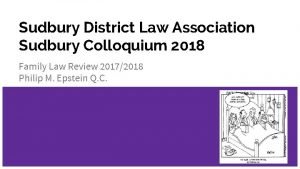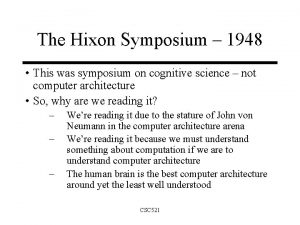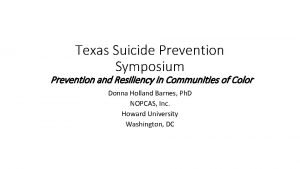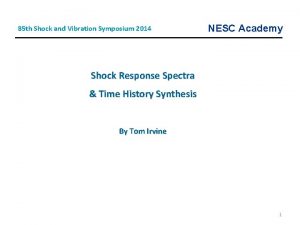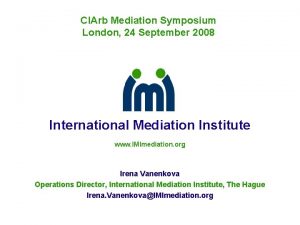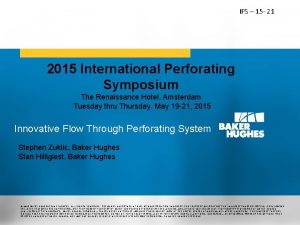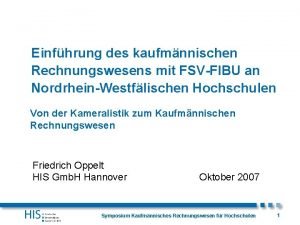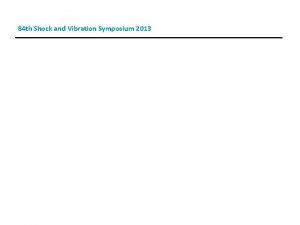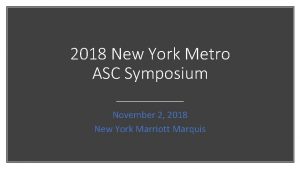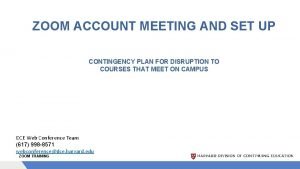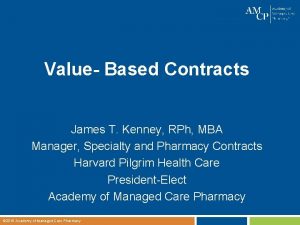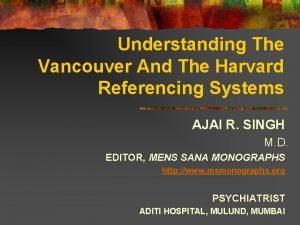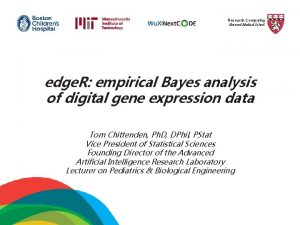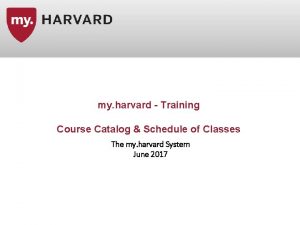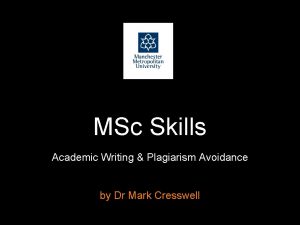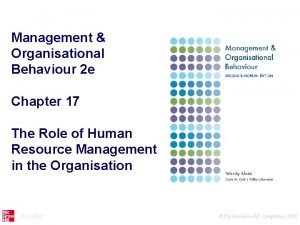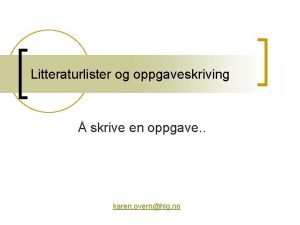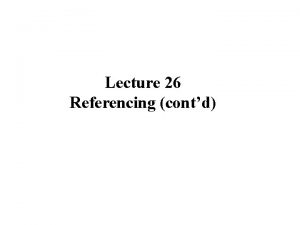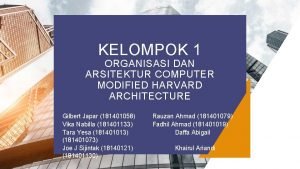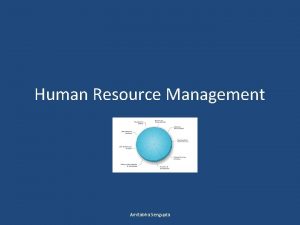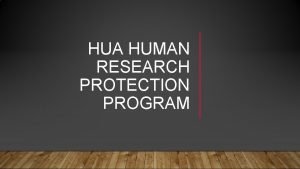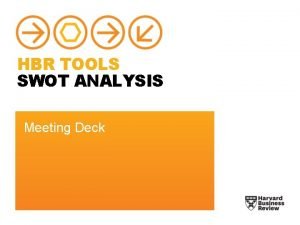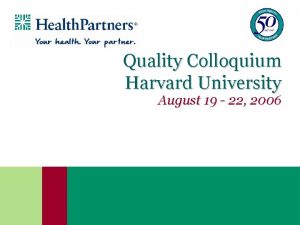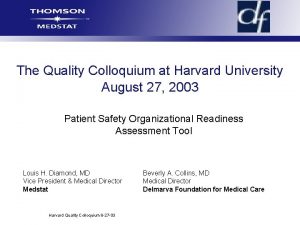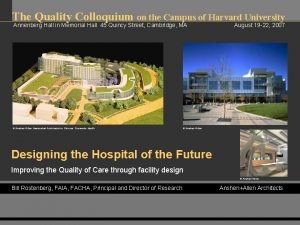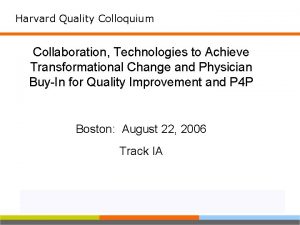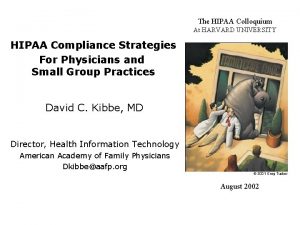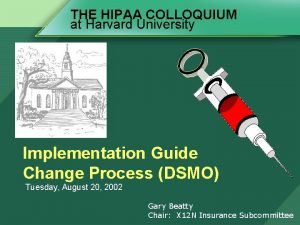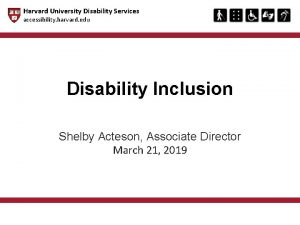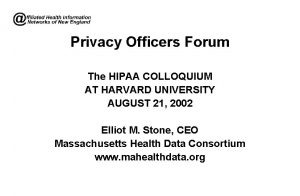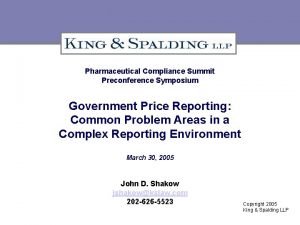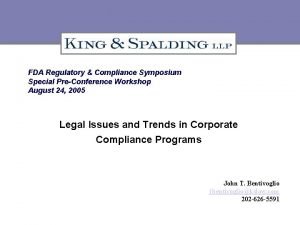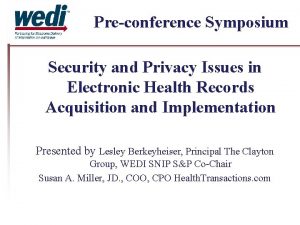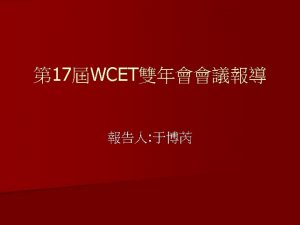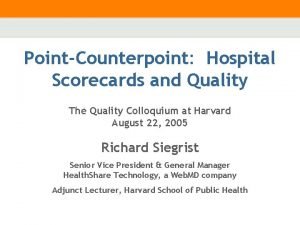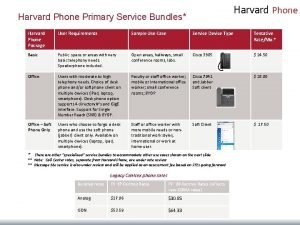The Quality Colloquium at Harvard University PreConference Symposium





























































































































- Slides: 125

The Quality Colloquium at Harvard University Pre-Conference Symposium Patient Safety Officer Certificate Training Paul Barach, MD, MPH Davis Balestracci, MS Becki Kanjirathinkal, MS, RN, CPHQ, CMQ/OE, CPHRM Julie K. Johnson, MSPH, Ph. D Sunday, August 19, 2007 1

Our Aim n The purpose of the Pre-Conference Symposium on Patient Safety is to give participants the understanding and tools necessary to conduct state-of-the-art clinical practice improvement projects and help direct the patient safety program at their organizations 2

Learning Objectives n By the end of this Patient Safety Officer Training, participants will be able to – Summarize the current state of safety – Translate national research into actionable improvement activities in his/her local setting – Identify key safety challenges – Use quality improvement methods to design solutions that address clinical as well as non-clinical processes – Create a safety plan that will outline key activities for local implementation 3

What’s required? n There are 4 required elements – Pre-course reading (6 hours) – The Pre-Conference Symposium on Patient Safety (6 hours) – Select elements of the Harvard Colloquium meeting (10 hours) – Post meeting on-line assessment (1. 5 hours) 4

What’s required? n At the end of the course, participants will have 90 days to complete the on-line assessment module n Completion of the 4 elements of the training will earn the participants a certificate of Patient Safety Officer training completion 5

Today’s Agenda 12: 30 – 1: 00 – 1: 45 – 2: 00 – 3: 30 – 4: 00 – 4: 15 Introductions and Overview of Session Mental models and framing Break Background on Patient Safety and Core Curriculum Overview of Patient Safety Tools and Methods of Analysis Managing an Adverse Event: The Aftermath Small Group Exercise: Conducting a Root Cause Analysis Break 6

Today’s Agenda 4: 15 – 4: 45 – 5: 30 – 6: 00 – 6: 30 – 6: 45 Disclosure of Adverse Events: What Do You Do When Bad Things Happen? Applied Statistics and Data Analysis Tools Improving Safety, Implementing Change System and Organizational Aspects of Safety Small Group Exercise – Mapping the Pre. Conference Patient Safety Symposium to the rest of the Colloquium sessions Concluding comments, questions and Post Test logistics Adjourn 7

Introductions n Introduce yourself to your neighbors – who you are, where you from, your day-job, and your expectations of this session n We will cull expectations from the group 8

Who Are We? n We are an overloaded system n We cannot keep up with complex diagnostic and therapeutic technologies n We have not changed workflows and roles in the past couple of centuries n We have placed most emphasis on sickness control, not on health promotion n We face the same challenges everywhere, but are tackling them independently 9

Adverse Event Rates in Healthcare Amalberti, R, Auroy, Y, Berwick, D, Barach, P. Five System Barriers To Achieving Ultra-safe Health Care. Annals of Internal Medicine, 2005; 142: 756 -764. Cardiac Surgery Patient ASA 3 -5 Medical risk (total) Microlight flights helicopters Road Safety Himalaya mountaineering 10 -2 Very unsafe 10 -3 Blood transfusion Anesthesiology ASA 1 Chartered Flight Railways (France) Chemical Industry (total) 10 -4 Civil Aviation 10 -5 No system beyond this point Fatal Iatrogenic adverse events Nuclear Industry 10 -6 Ultra safe Risk 10

U. S. Adults Receive Half of Recommended Care Percent of recommended care received Source: Mc. Glynn et al. , “The Quality of Health Care Delivered to Adults in the United States, ” The New England Journal of Medicine (June 26, 2003): 2635– 2645. 11

Variation in death rates and charges in US hospitals 12

13

CPR Quality During Cardiac Arrest n Two companion studies of CPR quality – Chest compressions were not delivered half of the time and compressions were too shallow (“out-of-hospital”) – Quality of multiple CPR parameters was inconsistent and often did not meet published guidelines (“in-hospital”) Abella BS, Alvarado JP, Hyklebust H, et. al. Quality of Cardiopulmonary Resuscitation During In-Hospital Cardiac Arrest. JAMA, January 19, 2005, 293(3): 305 -310 14

THE PATIENT SAFETY CURRICULUM Patient Safety Domains Knowledge, Skills, Attitudes 1. Theoretical Foundations Microsystems, historical trends, chaos, complexity, competency and learning 2. Behavioral Aspects of Medical Professionalism Ethics, patient quality of life, resolution of conflict 3. Interpersonal Issues Communication, stress and coping 4. Human Factors and Ergonomics Design history, error taxonomies, safety tools, decision support systems, fatigue factors, user centered design 5. Systems Analysis Usability criteria , organizations and learning disasters, place for human error 6. 7. 8. QI Learning Injury Epidemiology Pareto/flow charts, and other QI tools, best practices, act cycles Workplace hazards, worker safety, phases of injury, medico-legal aspects Medication Adverse and near-miss reporting, ISMP tools and Safety website, look/sound-alikes Gilula, M. and Barach P. Creating a Patient Safety Curriculum: Purposive Sampling of Patient Safety Experts. 79 th Clinical and Scientific IARS Congress. S-143. Honolulu, Hawaii. March 12, 2005. ; Gilula, Barach, 2007. 9. Crisis Team work, shared decision making, situational 15

Mental Models and Framing Julie K. Johnson, MSPH, Ph. D 16

Overview n Describe mental models n Discuss how we use mental models to frame issues and how that framing both contributes to and limits our understanding of a situation n Explore the relationship between mental models, patient safety, and quality improvement 17

Before We Begin. . . n Choose an opponent for thumb wrestling n The goal is for you to win this competition as many times as you can in 15 seconds n Winning means pinning your opponent’s thumb (adapted from the Systems Thinking Playbook by Sweeney and Meadows) 18

What happened? n How many points did you get? n What were the assumptions you brought into this game? n How did your assumptions affect your behavior? 19

Mental Models n The images, assumptions, and stories we carry in our minds of ourselves, other people, institutions, and every aspect of the world n They determine what we see, and most importantly, how we act 20

What Might this Mean for Our Work? n For example, mental models from our work in clinical care – Frequent flyer – Patient non-compliance – “Difficult” patient/family n What are the implications for mental models as related to patient safety? For students, clinicians, administrators? 21

Mental Models n None are perfectly accurate n Differences in mental models explain how two clinicians can understand the same event differently n Are generally invisible to us – until we look for them 22

How Can We Surface Our Mental Models? n Working with mental models requires surfacing, testing, and improving our internal pictures of how the world works n 2 skills can be helpful – Reflection – understanding your own mental models and the implications – Inquiry – learning the questions you can ask to help you test your own and other’s mental models 23

Relationship of Mental Models to Framing n n Mental models frame what we see and how we respond Our mental models are internal Framing is the interaction of our mental models and the situation at hand Framing contextualizes the experience, e. g. , the safety event 24

Small Group Exercise – Exploring Frames Divide into groups of 4 – one person from each group will be selected to be the observer and note taker for the group n Each group will get a set of 3 postcards n – Each postcard is covered with a different frame that reveals only part of the postcard n Without uncovering the cards or revealing their frame to the group, discuss these questions: – What do you see within the frame? – What is the story you can tell? n Participants will then look at the cards and discuss: – How did your frame limit what you know? – How does someone else’s frame contribute to, or disrupt, your understanding of the issue? 25

Debriefing n What was your group’s experience with the exercise? – What surprised you? – What did you learn? How do your mental models affect the frames you use? n How might your professional framework limit what you know? n n How can you think about mental models and frames in the context of patient safety? 26

Break 27

Background on Patient Safety and Patient Safety Core Curriculum Paul Barach, MD, MPH 28

Institute of Medicine November 1999 n n n Human Error and performance limitations Establish near miss voluntary reporting systems and protect from discovery Creating Safety systems in health care organizations Errors lead as major cause of death, injury Create a safety culture Create and inculcate a safety curriculum Team training and simulation Establish national safety authority Anesthesiology—only clinical domain to make patient safety central to its mission Altman, et al. 2004 ---five years later-IOM most important report in 2 decades Wachter, 2006 ---C+ grade on report 29 card

In both aviation and medicine, people depend on technology as the solution… 30

Newer technology doesn’t eliminate error…… 31

Nor does even newer technology…. 32

Human Error Rates Error of commission (misreading a label) 3/1000 Error of omission (item embedded in procedure) Error of omission (without reminders) 3/1000 Error in simple arithmetic (with self check) 3/100 Personnel on different shift fail to check conditions unless directed by a checklist Errors under very high stress when dangerous activities are occurring rapidly 1/100 25/100 Adapted from: Park, K. Human Error. In Salvendy, G, ed. “Handbook of Human Factors and Ergonomics”, New York. John Wiley & Son, Inc. 1997: 163. 33

Human vs. Design Flaws n How many didn’t see two “the’s”? n Human errors (7%) can be reduced by rigorous practices/standardization/simulation training/ building a safety culture, etc. 34

The 93% vs. 7% Rule Negligent Conduct (People) Human Error (People) Reckless Conduct (People) Organizational Design 93% Knowing Violations (People) 35

Case I: The Role of Human Factors in an Unexpected MI n n n n A 45 -year-old women for parathyroidectomy with no past medical history, under general anesthesia After uneventful induction of anesthesia, the patient became hypotensive Resident gave 1 cc of phenylephrine HR went to 150’s and VT CPR required Epinephrine given ST changes; TEE-severe LV hypokenesis 36

Similar Vials: Atropine & Phenylephrine 37

Drug swap examples in last year n Neosyneprhine for Fentanyl n Norepinephrine for Dexamethasone n Atropine for Neosynephrine n Cis-atracurium for Neostigimine n Cefazolin and Vecuronium 38

Medication Cart Drawer—does Your Cart Look different? 39

Performance Shaping Factors Affecting Human Vigilance n n n Fatigue Environmental Conditions/Built Environment Task Design Psychological Conditions Competing Demands Hand offs/Sign outs 40

Medication ADEs Take-Home Points n Medication errors are the #1 cause of preventable adverse events in the OR, including death 41

Medication ADEs Take-Home Points n To reduce medication errors in the OR – Label syringes with color-coded, pre-printed labels conforming to ASTM standards – Use easily identified “ready-to-use” syringes to administer emergency drugs – Standardize location of medications on anesthesia cart – Always review “ 6 Right’s” (patient, drug, dose, route, time, concentration) – Safety engineered syringes (e. g. , red plunger 42 for relaxants)

Medication ADEs Take-Home Points n. A need for careful analysis of causal connections between drugs and adverse event – Non-standardized taxonomy makes it difficult to analyze – Nebeker J, Barach P, Samore M. Annals of Internal Medicine 2004; 140: 795 -801. – Jacobs J, et al. Annals of Thoracic Surgery, 2007 43

Consider the Microsystem Small group of clinicians and staff working together with a shared clinical purpose to provide care for a defined set of patients n The clinical purpose defines the essential parts of the microsystem n – – – n Clinicians and support staff Information and technology Care processes Source of excellence in health care organizations Mohr J, Batalden P, Barach P. Qual Saf Health Care 2004; 13 Suppl 2: 34 -8. 44

Microsystems Exist Within Other Systems Patient Selfcare System Community, Market, Social Policy System Macro Organization System Individual caregiver, team and System Clinical Microsystem 45

What Are the Essential Elements of a Microsystem? n Core team of health professionals n Defined population of patients they care for n Information & information technology n Support staff, equipment, environment n Processes, activities specific to accomplishing the aim 46

A Common View of a Clinical Organization Chief of Chiefs Chief of Doctors Chief of Nurses Chief of Information 47

Communication examples n n n n Vague--”Patient got into a little trouble”; “Mostly stable” Ambiguous-”Patient went south” Confusing-“He was all over the place but you don’t have to worry about that” Lack specificity-”I gave him a little propofol” Imprecise Analogies-”He was like a rollercoaster” Objectification and depersonification-”The Gall Bladder in room 34 is doing fine” 48 Derogatory--”Circling the drain”; “GOMER”

How Do We Do At Sharing Information? n Verbal handoffs – Interruptions lead to diversion of attention, forgetfulness, and error (Coiera, BMJ 1998) n Written handoffs – Inconsistent – Missing code status, allergies, age, sex (Lee, JGIM 1996) 49

Hand-off as a Form of Communication “When you move from right to left, you lose richness, such as physical proximity and the conscious and subconscious clues. You also lose the ability to communicate through techniques other than words such as gestures and facial expressions. The ability to change vocal inflection and timing to emphasize what you mean is also lost…Finally, the ability to answer questions in real time, are important because questions provide insight into how well the information is being understood by the listener. ” –Alistair Cockburn 50

Role of Hand-offs n Exchange of vital information n Shared mental models and cognition of patient status n Exchange and uptake of responsibility n Part of the microsystem life-cycle n Vital to Unit, patients, and workers survival 51

Shift changes in hospitals n Shift changes (handoffs, sign-outs) represent transitions that can impact the quality of patient care and patient safety n The literature in this area has been dominated by the nursing profession n We still know relatively little about the factors related to shift changes in health care that can undermine patient care 52

Errors in Communication – 1 night of sign-out n Was there anything bad that happened or almost happened last night because – the VERBAL sign-out wasn't as good as it could have been? – the WRITTEN sign-out wasn't as good as it could have been? 53

Errors in Communication – 1 night of sign-out Arora V, Johnson J, 2006; Arora V, Johnson, J, Barach, P, 2007 54

Process Mapping n Ovals are beginnings and ends n Boxes are steps or activities n Diamonds are decision points – Questions with yes/no answers n Arrow indicates direction and sequence 55

Anesthesia Resident to Nurse Hand-Off Clear delineation of roles/responsibility Back-up Behavior 56

The Nurses’ Voice There’s just lack of communication all the way around. As the nurse, you’re there with the patient the majority of the time, and a lot of times the doctor would go in, and let the patient know that he or she is going for whatever procedure or test, and write NPO after midnight. You have no idea! Instead of coming to that nurse, so everybody would be on the same wavelength… I don’t think we are included in anything other than what’s in the chart. The doctors think we have time to sit down and read every note…. Every consult…. And that doesn’t happen. We just don’t have time. The attendings look right through you! Don’t even acknowledge you! I find that to be a big problem, because it filters down. What kind of example are you setting for your residents and interns if you don’t even acknowledge the nurse? 57

The Physicians’ Voice Sometimes you realize that you are both working toward helping the patient. It’s not an antagonistic relationship -- you are both there to help this person get better and get out of the hospital…. That is really important to keep in mind. The nurses that I interact best with… We’re on the same page. We’ve got the same goals in mind. I would have to say, in general, the work relationship, the tone of the work relationship, is hostile. It’s become this huge battle rather than a collaborative effort. There’s a little bit of a feeling of us against them. 58

Factors in Nurse-Physician Communication 59

Hand-off Strategies in Settings with High Consequences for Failure n 21 strategies in all, here are the 7 for improving handoff update effectiveness – Face to face verbal update – Additional update from practitioners other than the one being replaced – Limit interruptions during update – Topics initiated by incoming as well as outgoing – Limit initiation of operator actions during update – Include outgoing teams’ stance toward changes to plans and contingency plans – Read-back to ensure that information was accurately received • Patterson, ES et al. 2004 60

Determine the Standard Content: ANTICipate Develop a checklist n Have disciplines customize to their needs n Can be used to evaluate the quality of hand-offs n Arora, et al, 2005 61

1. Understand attempt to reduce the variation in the process n All disciplines “required” a verbal hand-off n BUT due to competing demands (OR, clinic, etc. ), this verbal communication sometimes did not occur – Educate residents on this important priority n Individual-level variation also present – “Some residents are better at making themselves available and touching base with you [during the hand-off] than others. . . ” 62

2. Hand-off = Transfer of information + professional responsibility n Transfers were at times separated in time and space – In one program, departing residents forward their pager to the on-call resident after they provide a verbal hand-off. – In another program, the on-call resident transfers a virtual pager to their own pager at a designated time which often occurs well before they receive a verbal hand-off. n Develop and train for hand-over competencies 63

3. Need to ensure “closed-loop” hand-off communication n In two cases, patient tasks were divided and assigned to other team members – To facilitate early departure of a post-call resident (to meet resident duty hour restrictions) – BUT results of these tasks were not formally communicated to anyone n Residents ensured “closed-loop” communication by building required follow -up on these tasks into the process 64

4. Keep the focus on patient care: Role Clarity and back-up behavior n Anesthesia resident to PACU RN – Interdisciplinary hand-off with challenging complex fast-paced environment n Clear delineation of responsibility to ensure patient care § Anesthesia resident to call out for a bed § Unit clerk to respond with bed # § PACU RN to hook up monitors n Equally important back-up behaviors § Can empower participants to focus on the patient care § “If nursing delay >30 sec, then resident to hook up monitors and call for RN” 65

Applications of a Standard Language n “Read-back” – Reduces errors in lab reporting “Read-backs” at your neighborhood Drive-Thru 29 errors detected during requested read-back of 822 lab results at Northwestern Memorial Hospital. All errors detected and corrected. Barenfanger, Sautter, Lang, et al. Am J Clin Pathol, 2004. 66

What are important team competency requirements? 67

Medical Team Training Team Competencies n Knowledge Competencies – The principles and concepts that underlie a team’s effective performance n Skill Competencies – The learned capacity (psychomotor and cognitive) to interact with other team members n Attitude Competencies – Internal states that influence team members to act in a particular way 68

The Team. STEPPS Framework n Knowledge n Attitudes n Performance – Shared Mental Model – Mutual Trust – Team Orientation – – – Adaptability Accuracy Productivity Efficiency Safety Baker D, Salas E, Battles J, King H, Barach P, 2005, 2007 69

Miller’s Pyramid Does Shows How Knows 70

Challenges to Medical Education Addressed by Simulation n n n Training clinicians in risky procedures on real patients is less acceptable Limited opportunities to experience rare events and crises Apprenticeship means you have to wait for something to happen Opportunities for reflective learning and deliberate practice Training for teamwork is rare Simulation is less costly 71

Uses of Simulators in Healthcare n n n Education and training of clinicians, engineers, medics, and ancillary personnel Evaluating new drugs and technologies Evaluating performance Credentialing Brief and de-brief planned surgery Team training n n n Disaster planning and preparedness Disclosure RRT n – Contingency training – Crises intervention (CRM) 72

Adaptive and Reflective Life-Long Learning Simulations Curriculum Learning Assess Competence Performing Learning Portfolios Yes No Knowledge Map 73

Barriers To Achieving Ultra-safe Healthcare n Acceptance of limitations on maximum performance n Abandonment of professional autonomy n Transition from mindset of craftsman to that of an equivalent actor n Develop a culture of safety n Simplify professional rules and regulations Amalberti R, Berwick D, Barach P. Annals of Internal Medicine 2005; 142: 756 -764. 74

Overview of Patient Safety Tools and Methods of Analysis Julie K. Johnson, MSPH, Ph. D 75

Managing an Adverse Event Small Group Exercise Conducting a Root Cause Analysis Julie K. Johnson, MSPH, Ph. D Paul Barach, MD, MPH 76

Tools and Methods of Analysis n Numerous methods and tools are available for analyzing adverse events, near misses, and the context of care n Regardless of the tool used, the goal is to determine at the organizational level how to prevent errors from occurring in the future 77

Tools and Methods of Analysis Thomas and Peterson identified eight of the most common methods used analyzed the strengths and weaknesses of each. They found that some methods are better for detecting latent errors --- the system errors --and some are better for detecting active errors and adverse events n An adverse event is usually the culmination of numerous latent errors plus an active error, so methods that explore the context of the systems in which the adverse event occurs are more appropriate for detecting latent errors n 78

Late nt E rror s Incident Reporting Types of Tools Act ive Erro rs Chart Review Autopsies and M&M Conferences Malpractice Claims Files Analysis Administrative Data Analysis Direct Observation Adv erse Eve nts Clinical Surveillance Information Technology 79

Tools and Methods of Analysis n Retroactive Analysis – Root Cause Analysis (RCA) is a thorough retrospective investigation to identify factors that contributed to the occurrence of an error n Proactive Analysis – Failure mode and effects analysis (FMEA) identifies potential contributing factors to potential adverse events 80

Adverse Event Management Plan Containment Plan • Render care to pt • Staff Support • Contain risk of harm/recurrence • Notification • Securing scene Event Activation Crisis Mgt Team Investigation & RCA Recovery Monitoring Restitution Corrective Action & Prevention Communication Plan Disclosure/ • Patient Organizational • External Audience Recovery • Internal Audience • Notify Billing to hold bills Immediate Response Follow-up Response 81

A Microsystem Framework for Analyzing Events n One method that we have found to be useful for systematically looking at patient safety events builds on Haddon’s overarching framework on injury epidemiology 82

The Haddon Matrix Human Vehicle Environment Pre-event Alcohol intoxication Braking capacity Visibility of hazards Event Resistance to injury insults Sharp, pointed edges and surfaces Flammable materials Rapidity of energy dissipation Emergency medical response Post-event Hemorrhage Source: Haddon, W. A Logical Framework for Categorizing Highway Safety Phenomena and Activity. J. Trauma 1972; 12: 197. 83

Haddon Matrix adapted to Patient Safety in the Microsystem Patient/ Family Systems/ Health Care Professional Environment Pre-event Event Post-event 84

Small Group Exercise n Patient safety scenario and the Haddon Matrix n Allison’s Story – See video and handout 85

Debriefing Patient/ Family Pre-event Event Postevent Health Care Professional Systems/ Environment Orientation to the Probablistic Risk process Assessment (PRA) Scenario Building Hazard Analysis Checklists Failure Modes Effects Analysis (FMEA) Human Factors Engineering Interview Crew Resource Management (CRM) Checklists Root Cause Analysis (RCA) Interview, Focus Group Interviews Microsystem Analysis Morbidity and Mortality Conference (M&M) Root Cause Analysis (RCA) 86

Elements of Organizational Accidents Task and Environmental Conditions Individual Unsafe Acts Organizational Processes Failed Defenses James T. Reason. The Human Factor in Medical Accidents. Vincent C, Ennis M, and Audley R. Oxford University Press 1993 87

Organizational Accident Causation Model Organization Workplace Person/team Defenses Management Decisions & Organisational process Accidents Latent conditions pathway 88

Elements of Organizational Failure n n n n Incompatible Goals Organizational Structural Deficiency Inadequate Communications Poor Planning and Scheduling Inadequate Control and Monitoring Design Failures Deficient Training Inadequate Maintenance Management JT Reason 1993 89

Organization Accident Causation Model Organization Workplace Management Decisions & Organisational process Error & Violation Producing conditions Person/team Defenses Accidents Latent conditions pathway 90

Workplace Conditions Promoting Unsafe Acts n n n High Workload Inadequate Knowledge, Ability or Experience Inadequate Supervision or Instruction Stressful Environment Mental State Change 91

Workplace Error Producing Conditions n n n Unfamiliarity(x 17) Time Shortage(x 11) Poor Human-System Interface (x 8) Information Overload (x 6) Negative Transfer(x 5) Misperception of Risk (x 4) n n n Inexperience Not Lack of Training (x 3) Inadequate Checking (x 3) Poor Instructions(x 3) Educational Mismatch (x 2) Disturbed Sleep (x 1. 6) 92

Work Environment Violation Producing Conditions n n n n Lack of Safety Culture Management/Staff Conflict Poor Morale Poor Supervision Condones Violations Misperception of Hazard Lack of Management Concern n n n Little Pride in Work Macho Culture “Bad outcomes Won’t Happen” Low Self-Esteem License to Bend Rules Ambiguous or Meaningless Rules 93

Organizational Accident Causation Model Organization Workplace Management Decisions & Organisational process Error & Violation Producing conditions Person/team Defenses Errors & violations Accidents Latent conditions pathway 94

Person /Team Individual Unsafe Acts n Errors – Attentional Slips and memory lapses (Intrusions, omissions) – Mistakes § Rule –based § Knowledge-based n Violations( deliberate deviation from regulation) – – Routine ( shortcuts) Optimizing Violations Exceptional Deliberate 95

Organizational Accident Causation Model Organization Workplace Management Decisions & Organisational process Error & Violation Producing conditions Person/team Defenses Errors & violations Accidents Latent conditions pathway 96

Break 97

Disclosure of Adverse Events: What Do You Do When Bad Things Happen? Becki Kanjirathinkal, MS, RN, CPHQ, CMQ/OE, CPHRM Paul Barach, MD, MPH 98

Adverse Event Management Plan Containment Plan • Render care to pt • Staff Support • Contain risk of harm/recurrence • Notification • Securing scene Event Activation Crisis Mgt Team Investigation & RCA Recovery Monitoring Restitution Corrective Action & Prevention Communication Plan Disclosure/ • Patient Organizational • External Audience Recovery • Internal Audience • Notify Billing to hold bills Immediate Response Follow-up Response 99

Small Group Exercise Disclosure 100

Disclosure Process n Identify incidence of patient harm or a potentially compensable event (PCE) n Initial disclosure and apology n Case Review n Follow-up disclosure n Discuss restitution 101

What do patients want? 1. To know what happened 2. To receive an apology 3. To know what is being done to prevent it from happening again 102

Disclosing Adverse Events n n Disclosure is required when – Has a perceptible effect on the patient not discussed in advanced with patient – Necessitates a change in patient care – Poses risk to patient’s future health – Involves non-consented treatment or procedure Reduces chances of being sued Transparency in process helps the team address guilt New laws in 22 states requiring disclosure Cantor M, Barach P, et al. Jt Comm Qual Patient Saf 2005; 31: 5 -12. Barach, P, Cantor M, 2007 103

Disclosure Conversation Planning Review disclosure principles n Decide who, when, where n – Decide who will be point contact person for patient/family What to say and how to say it n Anticipate questions n Planning next steps n Debriefing/emotional support for the individual(s) doing the disclosing n 104

Disclosure Conversation n Learn to effectively communicate and explain the facts n Expression n Discuss of concern/responsibility present/future needs n Describe actions taken and explain specific process for finding the answers 105

Risk Management Support n Manage contact with patient and/or family n Coordinate regulatory/accreditation requirements n Managing reputation risks – Media/Crisis communication – Internal and external n Managing complaints and claims – Early non litiginous settlement 106

Resources n n n Cantor M, Barach P, Derse A, et al. JCAHO 2005; 31: 5 -13. Kramam SS, Hamm G. Ann Intern Med 1999; 131: 963 -967. Clinton H, Obama B. NEJM 2006. Gallagher T, et al. NEJM 2007. http: //www. sorryworks. net Risk Management Pearls on Disclosure of Adverse Events. American Society for Healthcare Risk Management at http: //www. ashrm. org 107

Applied Statistics and Data Analysis Tools Davis Balestracci, MS 108

Improving Safety, Implementing Change Creating a Patient Safety Plan Becki Kanjirathinkal, MS, RN, CPHQ, CMQ/OE, CPHRM Paul Barach, MD, MPH 109

Patient Safety Plan High Reliability Organization Culture/ Leadership 2 Identify Failures Patient Centeredness Knowledge Sharing Teamwork / Human Factors Adapted from Kaiser Permanente Manage Failures Reliable Design 110

Microsystems Exist Within Other Systems Patient Selfcare System Community, Market, Social Policy System Macro Organization System Individual caregiver, team and System Clinical Microsystem 111

Vertical Alignment Vision (Aim) Safest Hospital Mission & Objectives Policy & Programs Tactics Expectations Behaviors Zero incidence of harm Right information, right place, right time Team based training Communicate clearly Safety KSA’s 112

Getting Started n Self-assessment – Alignment with organizational strategy – Program Infrastructure – Inventory of current patient safety activities § Resource allocation § Capacity – Results 113

Safety Program n Linkage with Leadership/Organizational Culture n Oversight responsibility/infrastructure n Stakeholder Engagement n Work Plan Development n Execution Model(s) n Monitoring/Measurement n Participation/accountability n Spread/Sustainability 114

Creating a Patient Safety Work. Plan AIM: Safest Hospital Objective: Zero incidence of harm Tactics – Crew resource management (CRM) – SBAR – Rapid response teams Source: Institute for Healthcare Improvement at http: //www. ihi. org 115

What’s on the Horizon for Patient Safety? n The role of the built environment n Patient centered processes n Smart automation n Adaptive informatics n Focus on the team and simulation n Full disclosure n Telemedicine/remote care 116

Knowledge & Skill Set n Leadership/Negotiation Principles n Human Factors Engineering n Behavioral Science Principles n Systems Thinking and Complexity Theory n Performance Improvement n Project Management n Change Management n Patient Safety Language Literacy 117

Resources n Advanced Training Program, Intermountain Healthcare, Salt Lake City. http: //intermountainhealthcare. org/xp/public/institute/courses/atp/ #objectives n Leadership Guide to Patient Safety from the Institute for Healthcare Improvement at http: //www. ihi. org n The University of Michigan Healthsystem Patient Safety Toolkit at http: //www. med. umich. edu/patientsafetytoolkit/ 118

Small Group Exercise – Mapping the Pre-Conference Patient Safety Symposium to the rest of the Colloquium sessions Julie Johnson, MSPH, Ph. D Paul Barach, MD, MPH 119

What do you think is on the horizon for patient safety in the next 5 years? 120

Concluding comments, questions, and Post Test logistics 121

THE PATIENT SAFETY CURRICULUM Patient Safety Domains Knowledge, Skills, Attitudes 1. Theoretical Foundations Microsystems, historical trends, chaos, complexity, competency and learning 2. Behavioral Aspects of Medical Professionalism Ethics, patient quality of life, resolution of conflict 3. Interpersonal Issues Communication, stress and coping 4. Human Factors and Ergonomics Design history, error taxonomies, safety tools, decision support systems, fatigue factors, user centered design 5. Systems Analysis Usability criteria , organizations and learning disasters, place for human error 6. 7. 8. QI Learning Injury Epidemiology Pareto/flow charts, and other QI tools, best practices, act cycles Workplace hazards, worker safety, phases of injury, medico-legal aspects Medication Adverse and near-miss reporting, ISMP tools and Safety website, look/sound-alikes Gilula, M. and Barach P. Creating a Patient Safety Curriculum: Purposive Sampling of Patient Safety Experts. 79 th Clinical and Scientific IARS Congress. S-143. Honolulu, Hawaii. March 12, 2005. ; Gilula, Barach, 2007. 9. Crisis 122 Team work, shared decision making, situational

Rules for Health Care Design in the 21 st Century n Current Approach – Do no harm is an individual responsibility – Information is a record – Secrecy is necessary – The system reacts to needs – Professional autonomy drives variability n New Approach – Safety is a system property – Knowledge is shared and information flows freely – Transparency is necessary – Needs are anticipated – Decision making is evidence-based IOM. Crossing the Quality Chasm. National Academy Press, 2001. 123

Final Thoughts n We are in a transition phase – – – n From error counting to harm prevention From rules to migration From reports to stories From technology to more system mind-fullness From one size fits all to individualization / customization Focus on recovery and near misses Collaboration and sharing Algorithms and standardization Competency based training Careful automation Seasoned regulation Safety is not a “top-priority”---safety is a precondition 124

Adjourn 125
 Ttess
Ttess Family law sudbury
Family law sudbury Weather harvard university
Weather harvard university Melanie northrop harvard
Melanie northrop harvard Harvard track and field
Harvard track and field Maslow's hierarchy of needs harvard reference
Maslow's hierarchy of needs harvard reference Harvard reimbursement policy
Harvard reimbursement policy Hull university harvard referencing
Hull university harvard referencing Perform quality assurance
Perform quality assurance Project quality management pmp
Project quality management pmp Pmbok quality assurance vs quality control
Pmbok quality assurance vs quality control Ana model of quality assurance
Ana model of quality assurance Compliance vs quality
Compliance vs quality Basic concepts of quality
Basic concepts of quality Juran's three role model
Juran's three role model Crosby quality is free
Crosby quality is free What is tqm
What is tqm Hình ảnh bộ gõ cơ thể búng tay
Hình ảnh bộ gõ cơ thể búng tay Lp html
Lp html Bổ thể
Bổ thể Tỉ lệ cơ thể trẻ em
Tỉ lệ cơ thể trẻ em Voi kéo gỗ như thế nào
Voi kéo gỗ như thế nào Glasgow thang điểm
Glasgow thang điểm Hát lên người ơi
Hát lên người ơi Các môn thể thao bắt đầu bằng tiếng bóng
Các môn thể thao bắt đầu bằng tiếng bóng Thế nào là hệ số cao nhất
Thế nào là hệ số cao nhất Các châu lục và đại dương trên thế giới
Các châu lục và đại dương trên thế giới Cong thức tính động năng
Cong thức tính động năng Trời xanh đây là của chúng ta thể thơ
Trời xanh đây là của chúng ta thể thơ Cách giải mật thư tọa độ
Cách giải mật thư tọa độ Làm thế nào để 102-1=99
Làm thế nào để 102-1=99 Phản ứng thế ankan
Phản ứng thế ankan Các châu lục và đại dương trên thế giới
Các châu lục và đại dương trên thế giới Thơ thất ngôn tứ tuyệt đường luật
Thơ thất ngôn tứ tuyệt đường luật Quá trình desamine hóa có thể tạo ra
Quá trình desamine hóa có thể tạo ra Một số thể thơ truyền thống
Một số thể thơ truyền thống Cái miệng xinh xinh thế chỉ nói điều hay thôi
Cái miệng xinh xinh thế chỉ nói điều hay thôi Vẽ hình chiếu vuông góc của vật thể sau
Vẽ hình chiếu vuông góc của vật thể sau Nguyên nhân của sự mỏi cơ sinh 8
Nguyên nhân của sự mỏi cơ sinh 8 đặc điểm cơ thể của người tối cổ
đặc điểm cơ thể của người tối cổ Ví dụ về giọng cùng tên
Ví dụ về giọng cùng tên Vẽ hình chiếu đứng bằng cạnh của vật thể
Vẽ hình chiếu đứng bằng cạnh của vật thể Fecboak
Fecboak Thẻ vin
Thẻ vin đại từ thay thế
đại từ thay thế điện thế nghỉ
điện thế nghỉ Tư thế ngồi viết
Tư thế ngồi viết Diễn thế sinh thái là
Diễn thế sinh thái là Các loại đột biến cấu trúc nhiễm sắc thể
Các loại đột biến cấu trúc nhiễm sắc thể Thế nào là số nguyên tố
Thế nào là số nguyên tố Tư thế ngồi viết
Tư thế ngồi viết Lời thề hippocrates
Lời thề hippocrates Thiếu nhi thế giới liên hoan
Thiếu nhi thế giới liên hoan ưu thế lai là gì
ưu thế lai là gì Sự nuôi và dạy con của hổ
Sự nuôi và dạy con của hổ Khi nào hổ mẹ dạy hổ con săn mồi
Khi nào hổ mẹ dạy hổ con săn mồi Hệ hô hấp
Hệ hô hấp Từ ngữ thể hiện lòng nhân hậu
Từ ngữ thể hiện lòng nhân hậu Thế nào là mạng điện lắp đặt kiểu nổi
Thế nào là mạng điện lắp đặt kiểu nổi Riviere fabes symposium
Riviere fabes symposium Hixon symposium
Hixon symposium Importance of symposium for students
Importance of symposium for students International police executive symposium
International police executive symposium Texas suicide prevention symposium
Texas suicide prevention symposium Denver metro speech language symposium
Denver metro speech language symposium Equally well symposium
Equally well symposium Nesc academy
Nesc academy Question about family symposium
Question about family symposium Malihka burmese restaurant
Malihka burmese restaurant Kanino nagmula ang epiko
Kanino nagmula ang epiko Chelsea modular homes
Chelsea modular homes Ciarb mediation symposium
Ciarb mediation symposium Florida hazmat symposium
Florida hazmat symposium Acm symposium on cloud computing
Acm symposium on cloud computing Symposium
Symposium Objectives of symposium
Objectives of symposium Banking analytics symposium
Banking analytics symposium Ips perforating
Ips perforating International perforating symposium
International perforating symposium Chara screenshot
Chara screenshot Ips perforating
Ips perforating International perforating symposium
International perforating symposium Symposium
Symposium Geo virtual symposium
Geo virtual symposium International perforating symposium
International perforating symposium Eurographics symposium on rendering
Eurographics symposium on rendering Ecfa symposium
Ecfa symposium Csi bible symposium
Csi bible symposium Slag valorisation symposium 2021
Slag valorisation symposium 2021 Symposium brugge
Symposium brugge University of southern california
University of southern california Title iii symposium
Title iii symposium Telpas speaking rubric
Telpas speaking rubric International symposium on molecular spectroscopy
International symposium on molecular spectroscopy Meaning:symposium
Meaning:symposium Doppik
Doppik Vsv symposium
Vsv symposium Navmat p-9492
Navmat p-9492 Ny metro asc symposium new york
Ny metro asc symposium new york Ncsu undergraduate research symposium
Ncsu undergraduate research symposium 沈榮麟
沈榮麟 Harvard zoom account
Harvard zoom account Bibliografiese bibliografie voorbeeld
Bibliografiese bibliografie voorbeeld Jim kenney harvard pilgrim
Jim kenney harvard pilgrim Harvard referencing sytem
Harvard referencing sytem Lj wei harvard
Lj wei harvard Harvardin järjestelmä
Harvardin järjestelmä Harvard eksempler
Harvard eksempler Kutipan harvard style
Kutipan harvard style Research computing harvard
Research computing harvard Rgu library harvard referencing
Rgu library harvard referencing Examples of vancouver referencing style
Examples of vancouver referencing style Gmas
Gmas Harvard class schedule
Harvard class schedule Mmu harvard referencing
Mmu harvard referencing Harvard student agency
Harvard student agency Harvard model of hrm
Harvard model of hrm Homeless to harvard questions
Homeless to harvard questions Harvard litteraturliste
Harvard litteraturliste Examples of harvard referencing
Examples of harvard referencing Harvard reference page
Harvard reference page Pengertian arsitektur harvard
Pengertian arsitektur harvard How to reference a case study harvard
How to reference a case study harvard Fombrun model
Fombrun model Harvard estr
Harvard estr Swot analysis for healthy food
Swot analysis for healthy food

